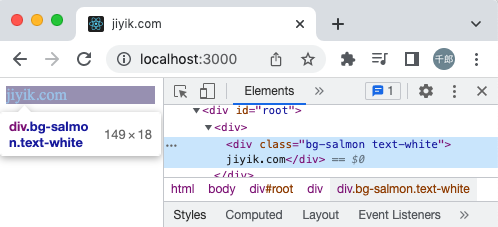Applying global CSS styles in React applications
To apply global CSS styles in your React application, write the CSS in a file with .css extension and import it in your index.js file.
The global CSS should be imported in index.js to ensure it is loaded on all pages of your React application.
Below is an example of an index.css file that declares 2 globally available classes.
.bg-salmon {
background-color: salmon;
}
.text-white {
color: white;
}
Here is how we can import the index.css file in the index.js file .
// 👇️ import css
import './index.css';
import {createRoot} from 'react-dom/client';
import App from './App';
const rootElement = document.getElementById('root');
const root = createRoot(rootElement);
root.render(
<App />
);
The above example assumes that our index.css file is in the same directory as our index.js file.
When importing global CSS files in React, the best practice is to import the CSS file into the index.js file.
The index.js file is the entry point for your React application, so it always runs.
On the other hand, if we import a CSS file into a component, the CSS styles may be removed once our component unmounts.
We can apply global styles in any file.
Here is an example App component that uses these two classes.
const App = () => {
return (
<div>
<div className="bg-salmon text-white">jiyik.com</div>
</div>
);
};
export default App;

Applying global CSS styles in React applications using CSS Modules
If you're using CSS Modules to style your React app, you can :globalswitch to the global scope by passing the current selector to .
:global(.bg-salmon) {
background-color: salmon;
}
If a selector is switched to global mode, it will not be modified by CSS Modules and will be available globally.
For reprinting, please send an email to 1244347461@qq.com for approval. After obtaining the author's consent, kindly include the source as a link.
Related Articles
How to avoid cross-origin (CORS) issues in React/Next.js
Publish Date:2025/03/17 Views:170 Category:NETWORK
-
In this article, we will introduce how to avoid cross-origin (CORS) issues in React/Next.js. Cross-origin resource sharing (CORS) is a protocol that defines how web requests should be handled when crossing different URLs.
React Tutorial - Transferring Props
Publish Date:2025/03/16 Views:188 Category:React
-
React transfers Props. Props are generated when components are encapsulated. Components expose some properties (Props) to the outside world to complete some functions.
React Tutorial: Props Anti-Pattern
Publish Date:2025/03/16 Views:187 Category:React
-
React's Props anti-pattern, using Props to generate state in getInitialState is an anti-pattern - Anti-Pattern.
React Tutorial - Props Validation
Publish Date:2025/03/16 Views:102 Category:React
-
Props validation is a very useful way to use components correctly. It can avoid many bugs and problems as your application becomes more and more complex. In addition, it can make your program more readable.
React tutorial: Types of Props for child components
Publish Date:2025/03/16 Views:172 Category:React
-
Usually, the child components of a React component are a group, that is, the child components are an array. Introduction to Type of the Children Props.
How to solve the error Uncaught TypeError: Cannot read properties of undefined in
Publish Date:2025/03/16 Views:153 Category:React
-
In the process of React development, we often encounter some errors. Here we look at an error reported in App.js. The error is as follows: App.js:69 Uncaught TypeError: Cannot read properties of undefined (reading 'setState') at onInput
Why do you need to bind event handlers in React Class Components?
Publish Date:2025/03/16 Views:60 Category:React
-
When using React, we must have come across control components and event handlers. We need to use `.bind()` in the constructor of the custom component to bind these methods to the component instance. As shown in the following code:
Solution to the error "does not contain a default export" in React
Publish Date:2025/03/16 Views:191 Category:React
-
When we try to use `default import` to import from a module that does not have a `default export`, we get a "does not contain a default export" error. To fix the error, make sure the module has named exports and wrap the import in curly braces, e.g.
Error in React: Attempted import error 'X' is not exported from Solution
Publish Date:2025/03/16 Views:78 Category:React
-
In React, the error “Attempted import error 'X' is not exported from” in React.js occurs when we try to import a named import that does not exist in the specified file. To fix the error, make sure the module has named exports and you have not obfu

